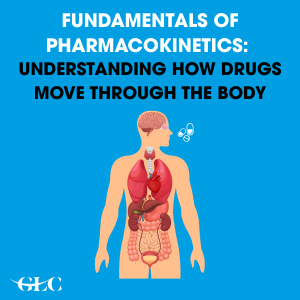Free knowledge to monitor the world of events. Have a look at our must read Blogs on Pharma, Finance, HR, Health and Cross Industry.
Fundamentals of Pharmacokinetics: Understanding How Drugs Move Through the Body
2022-08-16
When a patient takes a medicine a pill, an injection, or an inhaler the story doesn't end.
The drug goes on an interesting journey through the body that determines how well it works, how long it lasts, and how safely it can be administered. This journey is explained in terms of pharmacokinetics, a basic concept of pharmacology that addresses what the body does to the drug.
Pharmacokinetics helps researchers, practitioners, and pharmacists better understand how a drug is absorbed, distributed, metabolized, and excreted the ADME process for short. Let's review these fundamentals in simple terms.
- Absorption How Drugs Enter the Bloodstream
A drug, initially, must enter the bloodstream in order to be effective. Absorption is how a drug moves from where it was given to the blood.
- The route of administration (oral, intravenous, intramuscular, transdermal, etc.) determines how quickly and effectively absorption occurs.
- Bioavailability is the amount of the dose that is delivered to systemic circulation. For instance, orally given drugs undergo first-pass metabolism in the liver, hence reducing bioavailability.
Example: Paracetamol taken orally only gets a fraction of the dose into your blood due to liver metabolism.
- Distribution Where Drugs Spread Around the Body
After entering the bloodstream, a drug distributes itself to tissues and organs throughout the body. Distribution is influenced by factors such as:
- Blood delivery to various tissues
- Protein binding (some drugs bind to plasma proteins like albumin)
- Lipid solubility (lipid-soluble drugs diffuse cell membranes more easily)
The body is considered to be a series of "compartments" i.e., blood, fat, and muscle into which the drug is delivered at varying concentrations.
Example: Lipid-soluble drugs like diazepam accumulate in fatty tissues, prolonging action.
- Metabolism The Way the Body Chemically Processes Drugs
The majority of drugs are metabolized by the body as foreign chemicals and tried to eliminate them. Metabolism (or biotransformation) is the process of drug conversion to more water-soluble forms for excretion.
Metabolism occurs mainly in the liver, mostly through enzyme systems such as cytochrome P450 (CYP450). Metabolism occurs in two broad phases:
- Phase I reactions: Oxidation, reduction, or hydrolysis adding or uncovering functional groups.
- Phase II reactions: Conjugation attaching the drug to another molecule (like glucuronic acid) to make it more water-soluble.
Example: Codeine is metabolized in the liver to morphine which is actually the active form that inhibits pain.
- Excretion How Drugs Leave the Body
After metabolism, the body eliminates drugs by excretion mainly through urine by the kidneys, but also bile, sweat, saliva, and even air exhalation.
- Renal excretion is accomplished by filtration, secretion, and reabsorption processes in the kidneys.
- Defective kidney or liver function will slow excretion, with greater risk of toxicity.
Example: Penicillin-type drugs are eliminated in the urine in high amounts in the same form, and good kidney function must be present for safe excretion.
Key Pharmacokinetic Parameters
To define and contrast drugs, a number of important parameters are employed:
- Half-life (t½): The duration for the plasma level of a drug to decrease by one-half.
- Clearance (Cl): The plasma volume cleared of drug per unit of time.
- Volume of distribution (Vd): Shows the extent to which a drug distributes into body tissues.
- Area Under the Curve (AUC): Represents total drug exposure over time commonly employed for comparing various formulations.
Knowledge of these parameters aids clinicians in constructing peak dosing regimens to ensure therapeutic efficacy without toxicity.
Why Pharmacokinetics Matters
Pharmacokinetics bridges the gap between administration and effect of drugs. It makes it possible:
- Accurate calculation of dose and dosing interval
- Prediction of drug interaction
- Adjustment in patients with kidney or liver disease
- Development of new drug forms with increased efficacy and safety
Ultimately, pharmacokinetic know-how ensures that patients receive the right drug, in the right amount, at the right time.
Final Thoughts
Pharmacokinetics is the chemistry that makes every effective drug work. Through the knowledge of how drugs get absorbed, distributed, metabolized, and excreted, healthcare practitioners can make informed choices that achieve the greatest good with the least harm. Pharmacists, clinicians, and students alike need a solid understanding of pharmacokinetic principles to provide safe, effective, and successful patient care.
Do you want to understand more? Join our upcoming Fundamentals of Pharmacokinetic Masterclass
By Shara Najimudeen, Digital Marketing Executive, GLC Europe, Colombo Office, Sri Lanka.
Get a feel for our events

Training Program for CMC Leaders - EU edition
27th October 2025 - 16th January 2026
Rich with practical insights and real-world applications
learn more >>
Training Program for CMC Leaders - US edition
27th October 2025 - 16th January 2026
Rich with practical insights and real-world applications
learn more >>
Mastering the Common Technical Document (CTD) for Biologics Masterclass - EU edition
12-16 January, 2026
From guidelines to submissions
learn more >>















